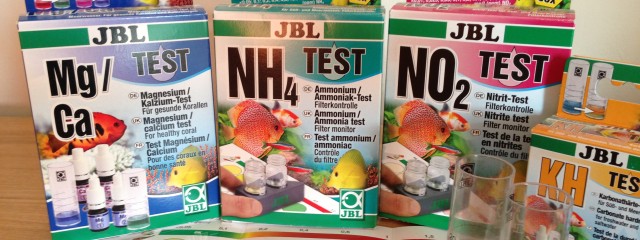All aquariums and ponds will contain levels of ammonia, nitrite and nitrate at some point in their history and especially when first set up. Maturation of the filters by carrying out sensible fish stocking over time and careful feeding along with regular maintenance will enable your aquarium or pond to thrive. After a feed levels of ammonia and nitrite will rise but healthy aquarium and pond filters will contain sufficient bacteria to break down the harmful ammonia and nitrite and convert it into the non toxic nitrate form before it becomes a problem. Regular water testing enables us to solve any minor changes before it becomes too serious.
At maltby aquatics we provide free water testing and analysis with all visits and help you understand whats going on in your aquarium or pond…
water quality, the benchmark…
There are three main water quality parameters that apply to everyone’s pond or aquarium that i have covered in this blog post.
- Ammonia (NH3) 0-0.05
- Nitrite (N02) 0-0.05
- Nitrate Freshwater Pond or Aquarium (N03) 0-15
- Nitrate Coral Reef (N03) 0-5
Lets not forget pH and temperature which are also very important standard parameters however they are dependent on the fish you keep, these and also more specific parameters from specialised setups will be covered in later posts.
Ammonia (NH3)
Ammonia is toxic to fish and builds up due to poor pond maintenance and/ or inadequate filtration. Fish waste, decaying plants and uneaten food are the main causes of ammonia build up, mature efficient filtration will break down the harmful ammonia and convert it into Nitrite which although still harmful to fish it is not as toxic.
High Ammonia readings 0.25+ will cause the burning of fishes gills and cause them to breath rapidly on the surface of the water, irreversible damage will occur to the gills if ammonia is present for periods over a few days.

Nitrite (NO2)
Nitrite is the next stage in the nitrogen cycle and is made due to the breakdown of ammonia. Nitrite is still toxic but will affect the uptake of oxygen in the haemoglobin and will not cause irreversible effects like ammonia. However high levels of nitrite will still kill fish as they will suffocate. Mature efficient filtration systems will house all the necessary friendly bacteria to break down the nitrite and convert it into the end product of the nitrogen cycle Nitrate.
High Nitrite levels are deadly and must be addressed immediately.

Nitrate (NO3)
Nitrate is the end product of the nitrogen cycle and although non toxic to fish it is still advisable to keep it around the 15ppm mark for tropical freshwater aquariums (coral reef aquariums <2ppm). Long periods of high Nitrate can weaken fishes immune systems and cause secondary infections to occur. Regular water changes and siphoning of your aquarium will keep Nitrate levels low. Fast growing plants are also a great way of keeping Nitrate levels low in your aquarium and pond.

Having a test kit is really important when looking after fish, the first thing to check whenever a fish looks ill or is acting odd are these water quality parameters discussed above. most problems are usually water quality related so be sure to test your water..










